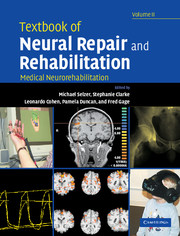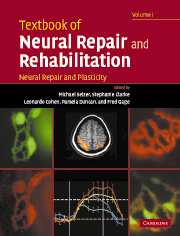37 results
Mechanisms of Action of Neural Grafts in the Limbic System
-
- Journal:
- Canadian Journal of Neurological Sciences / Volume 15 / Issue 2 / May 1988
- Published online by Cambridge University Press:
- 18 September 2015, pp. 99-105
-
- Article
-
- You have access
- Export citation
Dominance: Measure first and then define
-
- Journal:
- Behavioral and Brain Sciences / Volume 4 / Issue 3 / September 1981
- Published online by Cambridge University Press:
- 04 February 2010, pp. 440-441
-
- Article
- Export citation
Neuronal Replacement After Traumatic or Age-Dependent Brain Damage: A Review of Experimental Work in Rodents and its Clinical Implications
-
- Journal:
- International Journal of Technology Assessment in Health Care / Volume 1 / Issue 1 / January 1985
- Published online by Cambridge University Press:
- 10 March 2009, pp. 93-107
-
- Article
- Export citation

Textbook of Neural Repair and Rehabilitation
-
- Published online:
- 04 August 2010
- Print publication:
- 16 February 2006
Section A2 - Therapeutic technology
-
- Book:
- Textbook of Neural Repair and Rehabilitation
- Published online:
- 04 August 2010
- Print publication:
- 16 February 2006, pp 68-70
-
- Chapter
- Export citation
Section B2 - Determinants of regeneration in the injured nervous system
-
- Book:
- Textbook of Neural Repair and Rehabilitation
- Published online:
- 05 March 2012
- Print publication:
- 16 February 2006, pp 363-364
-
- Chapter
- Export citation
Neural repair and rehabilitation: an introduction
-
- Book:
- Textbook of Neural Repair and Rehabilitation
- Published online:
- 04 August 2010
- Print publication:
- 16 February 2006, pp xxvii-xxxvi
-
- Chapter
- Export citation
Section B3 - Cognitive neurorehabilitation
-
- Book:
- Textbook of Neural Repair and Rehabilitation
- Published online:
- 04 August 2010
- Print publication:
- 16 February 2006, pp 411-412
-
- Chapter
- Export citation
Contents
-
- Book:
- Textbook of Neural Repair and Rehabilitation
- Published online:
- 05 March 2012
- Print publication:
- 16 February 2006, pp v-viii
-
- Chapter
- Export citation
Frontmatter
-
- Book:
- Textbook of Neural Repair and Rehabilitation
- Published online:
- 05 March 2012
- Print publication:
- 16 February 2006, pp i-iv
-
- Chapter
- Export citation
Section C - Disease-specific neurorehabilitation systems
-
- Book:
- Textbook of Neural Repair and Rehabilitation
- Published online:
- 04 August 2010
- Print publication:
- 16 February 2006, pp 513-514
-
- Chapter
- Export citation

Textbook of Neural Repair and Rehabilitation
-
- Published online:
- 05 March 2012
- Print publication:
- 16 February 2006
Section B3 - Promotion of regeneration in the injured nervous system
-
- Book:
- Textbook of Neural Repair and Rehabilitation
- Published online:
- 05 March 2012
- Print publication:
- 16 February 2006, pp 443-444
-
- Chapter
- Export citation
Index
-
- Book:
- Textbook of Neural Repair and Rehabilitation
- Published online:
- 04 August 2010
- Print publication:
- 16 February 2006, pp 699-754
-
- Chapter
- Export citation
Section A - Neural plasticity
-
- Book:
- Textbook of Neural Repair and Rehabilitation
- Published online:
- 05 March 2012
- Print publication:
- 16 February 2006, pp 1-2
-
- Chapter
- Export citation
Contributors
-
- Book:
- Textbook of Neural Repair and Rehabilitation
- Published online:
- 04 August 2010
- Print publication:
- 16 February 2006, pp xxi-xxvi
-
- Chapter
- Export citation
Contributors
-
- Book:
- Textbook of Neural Repair and Rehabilitation
- Published online:
- 04 August 2010
- Print publication:
- 16 February 2006, pp xv-xx
-
- Chapter
- Export citation
Section B1 - Neural repair
-
- Book:
- Textbook of Neural Repair and Rehabilitation
- Published online:
- 05 March 2012
- Print publication:
- 16 February 2006, pp 267-268
-
- Chapter
- Export citation
Section B - Symptom-specific neurorehabilitation
-
- Book:
- Textbook of Neural Repair and Rehabilitation
- Published online:
- 04 August 2010
- Print publication:
- 16 February 2006, pp 215-216
-
- Chapter
- Export citation
Contents (contents of Volume II)
-
- Book:
- Textbook of Neural Repair and Rehabilitation
- Published online:
- 05 March 2012
- Print publication:
- 16 February 2006, pp ix-xii
-
- Chapter
- Export citation



